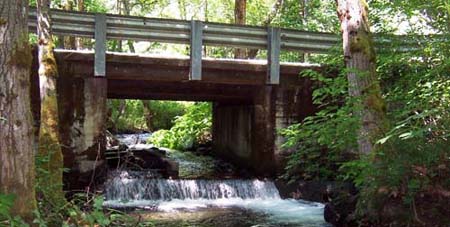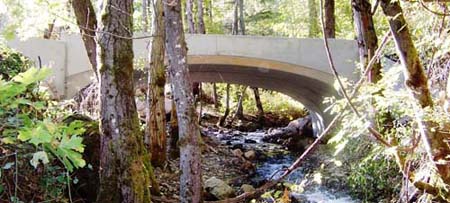|
Conner Creek Mouth Feasibility Study
Stream and habitat surveys conducted on Conner Creek in 1974, 1979, 1980, 2006 and 2011 noted several young of the year salmonids and resident trout as well as 1+/2+ steelhead but the “habitat is very capable of supporting steelhead and coho” (L. Everest, pers com 2008).
The Shasta Trinity National Forest (STNF) surveyed Conner Creek several times and is very interested in restoring full fish passage in the stream; “During our surveys we have only found juvenile steelhead/resident rainbow trout rearing here, but the habitat appears suitable for use by coho salmon. In 2001 the Trinity River experienced a very good run of coho salmon in conjunction with excellent migration conditions, coho salmon used many similar tributaries in the surrounding area that did not have recorded coho use but were not found in Conner Creek, presumably due to lack of access” (pers. comm. Loren Everest, Fishery Biologist, STNF).

Some of the problems facing coho in the Trinity River HU include degradation of spawning and winter rearing habitat, sparse spawning gravel recruitment, high summer water temperatures, lack of deep pools, migration barriers, and unscreened diversions (2004 Recovery Strategy for California Coho Salmon). This project builds on the work being done upstream to improve conditions for fish already utilizing the stream. This study will determine if there are additional projects that can be done in the lower 0.3 miles of the channel that will both improved existing habitat and increase species abundance in the system. Conner creek has cool-water, perennial flows, and can provide refugia for both steelhead and coho juveniles.
This project will determine if there are economical and hydrologically feasible opportunities to modify the mouth and or channel to allow unimpeded access during migration flows, and/or to add habitat elements to address the following limiting factors to salmonids: Spawning Requirements; Rearing Requirements; and, Fish Passage.

Background Information:
Conner Creek is located in the lower Trinity River HA, Helena HSA within the Southern Oregon-Northern California Coast evolutionarily significant unit (SONCC ESU) for coho salmon. Land use immediately surrounding the project area is rural residential, with the upper 90% of the watershed being managed by the Shasta-Trinity National Forest (STNF). Much of the watershed is roadless, including the entire east side of the drainage. The Miner/Eagle Fire complex burned in the upper 42 percent of the Conner Creek watershed in 2008 increasing the potential watershed impacts downstream.
Trinity County in partnership with the 5C Program has undertaken the removal of two migration barriers on Conner Creek upstream of this project area and downstream of the 2008 burned area. At Conner Creek Road a concrete box culvert with a fish weir and a 2’ jump at the outlet was a partial barrier to adult salmonids and a complete barrier to juveniles.
This feasibility study will look at the reach from the confluence with the Trinity River upstream for approximately 2,500’. This stream reach was heavily mined until 1954 and has numerous mining claims filed along the channel. In the 1890’s, or thereabouts, a tunnel was cut into schist bedrock approximately 900’ upstream of the mouth in order to divert the stream northwest of its original channel. The original channel was then mined for gold and portions buried and hydrologically disconnected.
The current channel within the mined reach consists of steep canyon sides incised through Salmon-Hornblende Schist bedrock parent material. The channel consists of steep pools and vertical walls in some areas, but the channel canopy is well vegetated with alder, cottonwood, blackberry, ponderosa pine and other species growing on the banks above the channel. The mouth of Conner Creek consists of a boulder/cobble delta that was purported to force stream flow subsurface, disconnecting the stream from the river.
Review of the mouth in September and October 2011 noted a small delta but with continuous flows connecting the stream and river. It appears that following the 11,000 cfs release from Trinity Lake this spring/summer the high flows may have broken down a substantial delta improving passage into the stream channel.
Additional Information:
Please contact us for more info.
| 